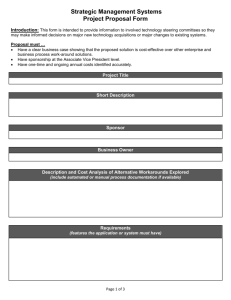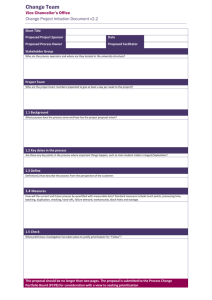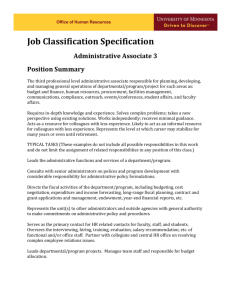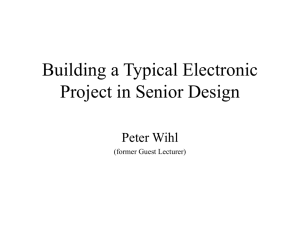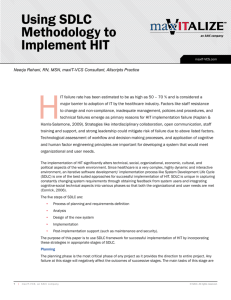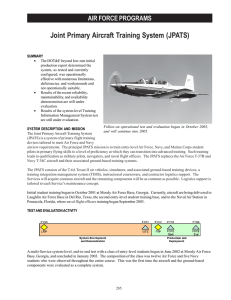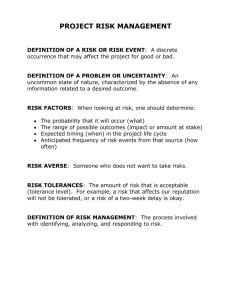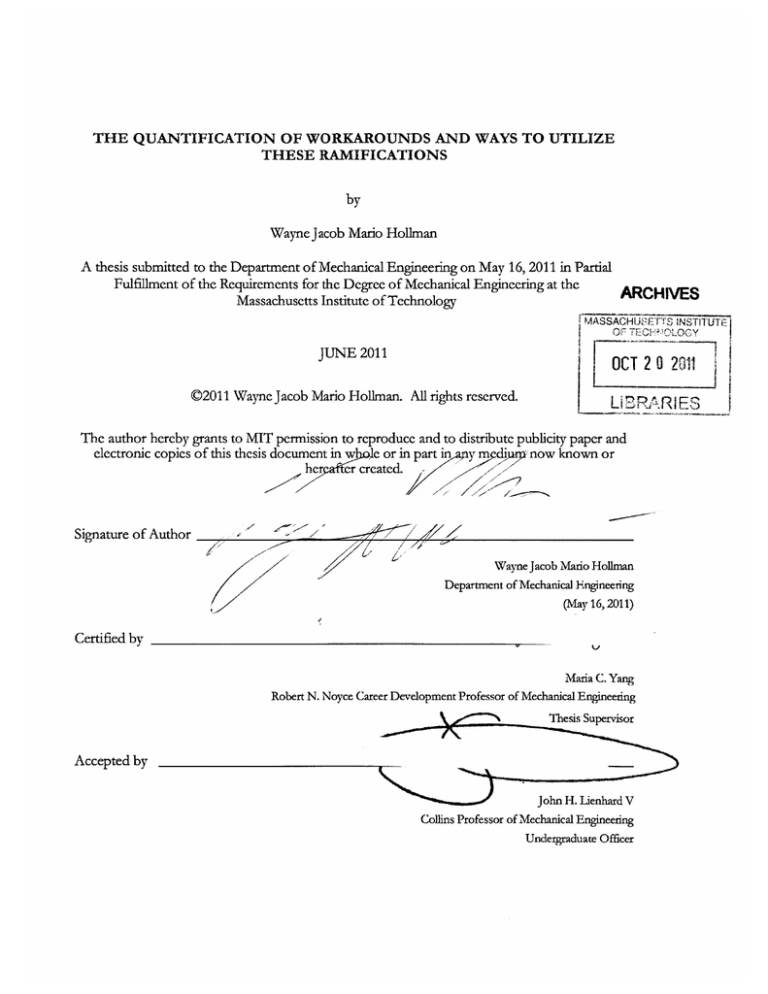
THE QUANTIFICATION OF WORKAROUNDS AND WAYS TO UTILIZE
THESE RAMIFICATIONS
by
Wayne Jacob Mario Hollman
A thesis submitted to the Department of Mechanical Engineering on May 16, 2011 in Partial
Fulfillment of the Requirements for the Degree of Mechanical Engineering at the
Massachusetts Institute of Technology
ARCHIVES
MASSACHU"ETT-S INSTITUTEI
OF TLcLooy
JUNE 2011
OCT
02011 Wayne Jacob Mario Hollman. All rights reserved.
LB.A R IES
The author hereby grants to MIT permission to reproduce and to distribute publicity paper and
r meiurg now known or
e or in part in
electronic copies of this thesis document in
he
r created.
7
Signature of Author
7-
-7
'7
7X
~
7
77
2
20 2011
Wayne Jacob Mario Hollman
Department of Mechanical Engineering
(May 16, 2011)
Certified by
Maria C. Yang
Robert N. Noyce Career Development Professor of Mechanical Engineering
Thesis Supervisor
Accepted by
John H. Lienhard V
Collins Professor of Mechanical Engineering
Undergraduate Officer
THE QUANTIFICATION OF WORKAROUNDS AND WAYS TO UTILIZE
THESE RAMIFICATIONS
by
Wayne Jacob Mario Hollman
A thesis submitted to the Department of Mechanical Engineering on May 16, 2011 in Partial
Fulfillment of the Requirements for the Degree of Mechanical Engineering at the
Massachusetts Institute of Technology
Abstract
User innovation is steadily becoming an irreplaceable factor in product development. Thus it is
necessary to find ways to measure these workarounds and ways to utilize these figures. I selected
three (3) particular styles of workarounds to quantify and discuss. With makeshift window
workarounds, I found that user workarounds in automobiles cost 84.9 times and households cost
67.9 less in magnitude compared to full repairs. Table adjustments workarounds were found to
be many times greater than then replacing the table and the gap became greater with the increase
in table price. Lastly examining medical instrument workarounds, I discovered that many these
innovations can create profitable, niche markets. By using workarounds in general, producers
can manufacture consumer desired products that generate revenue. In the future, I hypothesize
that companies will lower their research and development funding in place of observing
potentially, profitable workarounds.
Thesis Supervisor: Maria C. Yang
Title: Robert N. Noyce Career Development Professor of Mechanical Engineering
TABLE OF CONTENTS
1.
2.
3.
4.
5.
6.
7.
List of Figures ............................................................................................................................................
List of Tables..............................................................................................................................................5
A cknow ledgem ents ...................................................................................................................................
Introduction ...............................................................................................................................................
Background ................................................................................................................................................
2.1. Inventiveness.....................................................................................................................................9
2.2. Producer Innovation.......................................................................................................................10
2.3. U ser Innovation ..............................................................................................................................
Theoretical Fram ework...........................................................................................................................13
3.1. M aking U ser Workatounds M easurable..................................................................................
3.2. Selection of Workarounds.........................................................................................................
Analysis of Select Workarounds ........................................................................................................
4.1. M akeshift Windows........................................................................................................................18
4.1.1.Autom obile Window Repairs..............................................................................................18
4.1.2.H ousehold Window Repairs................................................................................................21
4.2. Table A djustm ents..........................................................................................................................23
4.3. Medical Instrum ents.......................................................................................................................24
4.3.1.Sanitation Equipm ent......................................................................................................
4.3.2. Surgical E quipm ent ..........................................................................................................
The Analysis of Workarounds N ationally ........................................................................................
5.1. D escription of Findings ............................................................................................................
5.1.1.M akeshift Window s........................................................................................................
5.1.2.T able A djustm ents..........................................................................................................
5.1.3. Medical Instrum ents ......................................................................................................
5.2. Summ ary ..........................................................................................................................................
Conclusion................................................................................................................................................33
Discussion ................................................................................................................................................
7.1. Applications.....................................................................................................................................34
7.2. Profitability ......................................................................................................................................
7.3. Future Steps.....................................................................................................................................36
References ................................................................................................................................................
A ppendix..................................................................................................................................................
4
5
6
8
9
10
13
15
16
25
25
27
27
28
30
31
32
34
35
38
41
LIST OF FIGURES
Number
Page
1) MW Workarounds: Car and House Examples.....................................................................................16
LIST OF TABLES
Number
2. Studies of Innovation Frequency Among Consumers in Specialized Communities ..............
Page
12
3. The Quantitative Representation of Workarounds on a Micro-Scale and Macro-Scale............33
ACKNOWLEDGMENTS
I would like to express my gratitude to many individuals who have assisted me in my research
here at M.I.T. I would like to especially thank my thesis advisor and mentor, Maria C. Yang.
Without her consistent support and guidance my graduation at M.I.T. would have only been a
dream. I would like to also thank Eric von Hippel for his breakthrough research in user
innovation. His research in user made products provided a strong foundation for this work.
Juanjuan Zhang guided me on the right path to finding which economic models to implement
and for this I give her great thanks. From my peers, I would like to thank AYssata E. Niitzel for
her constant encouragement and keeping me focused. Lastly, I would like to thank my family.
Because of their continuous support, encouragement, and love I was able to wake up in the
morning and live each day. I thank all of you for giving me the skills and strength to accomplish
this and much more. Thank You.
LIST OF TERMS
GDP gross domestic product
Micro-scale. From a small perspective (e.i. individuals, private businesses)
Macro-scale. From a large perspective (e.i. nationally, gross population)
Product A good or service
User Firms or individual consumers that expect to benefit from using a product or a service
Workarounds. The name of a user innovation or producer innovation where a product is used
not for its intended purposes
1. Introduction
Workarounds is a term that few know but many use. People call it "thinking outside of the box",
"freestyling "Mickey Mouseing", and sometimes "fixing it up". The average person in the United
States from the time when they wake up to the time when they sleep they experience or utilize various
workarounds. From using a cup to scoop out sugar or a chair as a table to boarding up your window
with plastic instead of glass are all workarounds. For the service of the article, workarounds can be
defined as a product or service derived from any user innovation. User innovations come in many
ways and styles from those that completely alter a product to those that only create a minute change in
a product that affects a niche group. The magnitude of variation of workarounds is even greater than
that of user innovations because the workaround could be the user innovation or the service that the
user innovation provides. Throughout this article we will examine to a certain degree of depth the
product aspect of workarounds.
In Section 2, Background, we will view the past of user innovations and producer innovations. User
innovations exemplify workarounds that is used in households or for leisure that consumers usually
develop out of need. Product innovations embody workarounds that is used in business sectors or for
productions. Product innovations are most commonly the byproduct of efforts for efficiency.
Theoretical Framework is Section 3 which highlights the approaches used to initiate findings and
utilize them. This section clarifies the various experts view on it as well as justifies the type of
calculations used. Section 4, Data Analysis of Selected Workarounds, gives the analytical view of each
selected workaround. Each selected workaround will be analyzed on a micro-scale to view the various
8
affects they have on individuals. In Section 5, The Analysis of Workarounds Nationally, I will show
the effects of workarounds on a macro-scale to illustrate the potential changes workarounds have to
the economy. Section 6, Utilizing Workarounds, will use the data collected to show how the
anticipating and manipulating workarounds can benefit individuals on a micro-scale and large
corporation on a macro-scale. The monetary value of these decisions will also be illustrated in this
section. In Section 7, Results, all of the data will be compiled to provide an overall understanding of
the ramifications of the workarounds analyzed. Through this summary a clear view of the affects will
be represented in the information. Section 8, Discussion, will reiterate the results from the data and
clarify the magnitude of impact workarounds possess. Also this section will voice several possible
future steps that will be helpful in steering society in its efforts to utilize workarounds. The goal of
this work is to look into the realm of workarounds and provide a solution where users and producers
can both benefit from a monetary standpoint.
2.Background
2. 1.
Inventiveness
Inventions come in various styles and locations but most fall under to distinct categories: invention
and innovation. Throughout this article I will look thoroughly at the sectors of innovation.
Innovations can be seen in office buildings, factories, and households in almost every area. The global
spread of these innovative progress shows that new product development by consumers is much
9
more than a niche phenomenon (von Hippel, P.J. de jong and Flowers 2010). The innovation in the
business sector can be generalized into either producer innovation (Section 2.2) or User innovation
(Section 2.3). Both concepts serve the same purpose of optimizing consumer satisfaction, but do so
in very different methods.
2.2.
Producer Innovation
Producer innovation, as described in this article, is the innovation efforts of a manufacturer. A
manufacturer is an individual or firm selling a product to a consumer. For example, Motorola is a
manufacturer of cell phones. If Motorola develops a phone that is able to take photographs and
videos simultaneously because they believe consumers would buy them is an example of producer
innovation. Motorola is choosing to use their resources and ingenuity to develop a new product that
the company believes would increase consumer satisfaction. Because of the relatively larger
satisfaction gained from using the new phone people would buy more phones which in turn increases
profit.
2.3.
User Innovation
User innovation, as described in this article, is the innovation efforts of a user. A user is an
individual or firm that purchases a product from a manufacturer. A firm can be a user in some
instances and a manufacturer in others. For example, Motorola who is a manufacturer of cell phones
is also a user of machines for circuits. Motorola purchase these machines and modify their constraints
to manufacture Motorola-specific cell phones. These types of innovations have made impacts in the
global product market.
User innovations have been an important component in the growth of the product market. Figure
1 illustrates this phenomenon. Development from users was shown to be most important with
respect to both improved functionality over previous best practice and commercial value compared to
manufacturers (von Hippel, P.J. dejong and Flowers 2010). User firms develop most of the
% developing
Number and Type of Users samp innovations
for personal use
Source
Innovation Area
1. Franke and Shah
(2003)
Extreme Sporting
2. Lithje et al.
(2005)
Mountain Biking
3. Tietz et al.
(2005)
Kitesurfing
287 Australian Kitesurfers
28%
4. Franke et al.
(2006)
Kitesurfng
K
456 Kite surfers
4 K s
30.7
197 members of 4 specialized
sporting clubs
291 mountain bikers
32.1%
19.2%
Table 1: Studies of Innovation Frequency among Consumers in Specialized Communities'
1Figure from von Hippel et al 2010 (See References)
11
important innovations in the oil refinery industry (Enos 1962). On a study done by "von Hippel
(1988) found that users were the developers of about 80 percent of the most important scientific
instrument innovations, and also the developers of 67% of the major innovations in semiconductor
processing" (von Hippel, P.J. de Jong and Flowers). The innovation of users is present in a wide
range of industries and is high quality.
The technical quality of user innovations maybe seen as not that high but in actuality the quality of
user innovation is no less than that of producer innovation. A particular study done by Lettl et al
(2007) reviewed around 3000 patent families "in surgical instruments, devices or methods." Initially
the citations for user innovations were lower than that of producer innovations which show the
quality of the user modifications. Also the user modifications were in more classes than that of the
producer innovations so the users incorporated a wider range of improvements. This shows that
users in this industry have not only noticed more defects in the various products and service, but
also made steps toward improving these defects. These users who choose to innovate are coined as
"lead users" by von Hippel et al (2010). Von Hippel et al (2010) define these users as having two
characteristics:
1) "Expecting major benefits from solutions to the novel needs they encounter"
2) "Being at the leading edge of important marketplace trends."
These characteristics define what is needed for user innovators to be successful in creating
worthwhile products. The products that "lead users" choose to innovate are usually products that
they use constantly and see defects in these products or the work that a "lead user" is doing needs a
product that has more specific features. Since these lead users are also consumers the demand for
these user innovated products are high. The increase in demand is due to the fact that there are
fewer assumptions about what would increase consumer satisfaction because the "lead user" knows
more about what is actually desired from the consumers. The study conducted by von Hippel
(2005) shows that many innovations come about from "lead users" need for a product then
producing it for other users to be able to use. There have also been studies in how the "lead user"
goes from designing to commercializing their innovations. Most of these products become
mainstream after they are adopted by other "lead users" and form user-companies. And only after
the market is obtaining surplus revenue does producer-driven companies join into the newly formed
market sector.
3. The oretical
3. 1.
Framework
Making User Workarounds Measureable
Since the idea of what user innovation is somewhat set, we can now look in to how can we examine
the effects of these products. It is almost impossible to pinpoint the user workaround market because
user innovation is done is almost every sector. In order to narrow down this broad market scope I will
only examine select user workarounds. These workarounds must have several distinct criteria in so
that these workarounds can be used to represent the entire market. These criteria are:
1) Must be applicable to all individuals of a similar socioeconomic status despite whatever
other differences
2) Must be able to obtain profit within a market
3) Must be "common"
Each of these criteria is necessary for the selected workarounds in order to extrapolate the findings to
a national scale. For the workaround to be applicable to the entire population is somewhat unrealistic
because as monetary income changes so does the quality of the products those individuals buy. With
these higher quality products less user innovation maybe needed. Though it the workaround is
applicable to an entire socioeconomic status then I will be able to use the analyzed data to illustrate the
effects on a macro-scale. By the workaround being applicable it would add validity to the fact that I
will use the data analyzed on a macro-scale. The workaround also have to show that profit can be
14
gained from the adoption of these workarounds. This is necessary to add validity to the fact that
workarounds affect the efficiency of resources used on products and the GDP of the nation (Section
5). Finally the selected workarounds must be "common" meaning that the workaround must be
commonplace within society. For example, to move one's hands back and forth is known to mean
hello. This gesture is "common" within most western nations. The selected workaround has to be
"common" to add reliability to the analysis. Without this factor the data that I obtain would be
useless.
3.2.
Selection of Workarounds
Based off of the aforementioned criteria, I have decided to analysis three (3) distinct workaround
categories: makeshift windows, table adjustments, and medical instrument workarounds. Makeshift
windows (MW) workarounds have a strong connotation with lower-middle and low socioeconomic
class individuals because of its wide spread use. Also this type of workaround is common within the
United States (see examples in Figure 2). In most urban areas in the country one would be able to see
a MW workaround on a vehicle or on a house. Because of this wide spread use many corporations
incur a loss of profit from MW workarounds. The table adjustments (TA) workarounds were selected
for similar reasons as the MW workarounds.
Figure 1: MW Workarounds: Car and House Examples
In many households across the nation one can find TA workarounds in the living area. Though
they are somewhat "common" in hospitals and other medical facilities, medical instruments (MI)
workarounds were mainly chosen for their profit-incurring potential. Many physicians either use or
have need for many medical innovations but are too busy to implement or ask for them. MI
workarounds have factors that will make countless producers enter the medical instrument industry.
4.Analysis
of Selected
Workarounds
In this analysis section I will use fairly, straight forward equation to develop the cost of each type of
selected workaround and compare that cost to the cost of alternatives. The equation does not account
for price fluctuation or competitor prices effect on the cost of materials. The developed equation is as
follows:
A.= Cost of the Workaround
PW = Price of Workaround Material
Q. = Amount
or Quantity of Workaround Material
W. = Average Wage per Hour
(Varies with Socioeconomic Class)
T = Time to Complete Workaround in Hours
A = Miscellaneous factor that is unique to each workaround
Ac = (P x(Qa) ± (W. x T)+ A
4.1.
Makeshift Windows
MW workarounds come in many forms but I will lump them into two groups for convenience. The
two groups of MW workarounds are automobile window repairs and household window repairs.
These two groups encompass almost all of the MW workarounds.
4.1.1.
Automobile Window Repairs
Automobile window repairs can possible comprise the largest amount of MW workarounds
nationally. Many individuals use clear plastic to cover their window with and use duck tape to adhere
it to the car's frame. This workaround is used instead of car replacements because of its relatively low
cost. I will compare the price of a passenger side, front window replacement with that of a common
user innovation which is plastic cover. These car window repairs can range from about $300 -$700
depending on the vehicle (Damewood 2011). I will use two common family sedans: 2010 Ford Taurus
4 door sedan, 2010 Honda Accord 4 door sedan. The prices of a window replacement for the 2010
Ford Taurus and 2010 Honda Accord are $353.95 and $281.95, respectively (2011). By taking the price
of plastic to be $ 75.00 for 100 (23 3/8" by 32 1/8")2 clear plastics bags, the price of duct tape to be
$4.00 per roll (1.88" by 20 yd) 3, and the average income of a household in the U.S. ($52,0294), I will
quantitatively compare the makeshift window workaround with the cost of repairs.
2 Information obtained from source 2 (See Reference)
3 Information
obtained from source 12 (See References)
18
Ford Taurus Makeshift Window:
Window Dimensions5 (Approximate): 20.2" by 42.27"
Perimeter of Window (Approximate): 124.94"
Average Time to Fix Window- 20 min
A. = [($75.00 + 506) + ($4.00 *149
20ydxx
3ft 12-
) + [ ($52,029 + 365 days X
iday
24hO
A ,= [$1.50 + $0.69] + [$1.98] + 0
A.
$4.17 for the 2010 Ford Taurus
Honda Accord Makeshift Window.
4
Information obtained from source 15 (See References)
5 Information obtained from source 19 (See References)
6Only 2 pieces of plastic is needed to cover window
7
I am not taking into account the possibility of theft, heat loss, and other miscellaneous factors
19
20mn] + 0
60min
Window Dimensions8 (Approximate): 19.37" by 40.60"
Perimeter of Window (Approximate): 119.94"
Average Time to Fix Window 20 min
= [($75.00 + 50) + ($4.00 *
11l%
d
3ft
day
)] + [ ($52,029 + 365 days x 24h
2 Omin.
x 6Om] + 0
12'
A,= [$1.50 + $0.67] + [$1.98] + 0
A,= $4.15 for the 2010 Honda Accord
As one can see the price to create a workaround as a MW for an automotive company is much less
that the cost of repair. The cost to get a window replacement for a 2010 Ford Taurus was around
$353.95 which is 84.9 times the $4.17 cost it takes make a MW. Also the $281.95 cost of a window
replacement for a 2010 Honda Accor d is 67.9 times the cost of its $4.15 MW replacement.
8Infornation obtained from source 9 (See References)
20
4.1.2.
Household Window Repairs
Another relatively common MW is replacing windows in one's home with the use of plastic.
This is almost identical to the MW automotive repairs. Many individuals develop this
workaround out of the need for a quick and simple fix to a window. We will compare a standard
price for window replacement with the cost of a workaround. The price of replacement windows
can range from $189 - $ 700 (eHow 2011). We will us the similar measurements as in the
Automotive Window Repairs section to compare the cost of a workaround to the replacement.
Household Makeshift Window:
Window Dimensions' (Approximate): 36" by 48"
Perimeter of Window (Approximate): 168"
Average Time to Fix Window: 30 min
A.
[($75.00
.
25') + ($4.00
+ [($52,029 + 365 days x
168"
20ydx
3ft
x
12-
9 Infornation obtained from source 20 (See References)
21
24hour
xsn
60m
+_0
A.= [$3.00 + $0.93] + [$2.97] + 0
A.= $6.90 for the Average Household Replacement
The cost to create a workaround as a MW for a home is much less that the cost to have a
professional come in to install a new 36" by 48" window. The cost to get a window replacement for
an average house window ranges from $189 to $700 which is 27.4 to 101 times the amount of a MW.
4.2.
Table Adjustments
Wobbling tables is a reoccurring theme throughout the world. After repeated use, various
sections of the table start to lose their straightness. Some might just get rid of the table, but
others who may have a connection with the table or tough financial situation seek a different
solution. From this TA workarounds are developed. TA workarounds a unique because most of
the time the table's repair cost is more than the table so the best alternative is actually buying a
new table. Also the workaround cost is relatively low because the items used for the workaround
is normally unused items around the house. Below is the depiction of the quantitative cost of TA
workarounds when a book or napkin/used paper are used. I will give the cost of a book the
value of $ x.00 because books' value vary a great deal so I am going to leave the value $x.00 for
10Takes for dear plastic bags to cover
the analysis. The price of the napkin/used piece of paper will be $0.00 because the paper at that
point is assumed to be trash which has a value of about $0.00.
Book Table Adjustment:
Cost of Used Book: $ x.00
Average Time to Adjust Table: 5 min
[$x.00] + [ ($52,029 + 365 days x
lday
24ho-ur
smin ]+
60mm
0"1
A = [$x.00] + [$0.49] + 0
A.= $x.00 + $0.49 for a TA workaround using a book
Used Napkin/Paper Table Adjustment:
Cost of Used Napkin/Paper $ 0.00
1 I am not taking into account the possibility of the table breaking, book size, and other miscellaneous
factors
Average Time to Adjust Table: 5 min
=
[$0.00] + [ ($52,029 + 365 days x
"
24hours
xmin ] + 012
60mm"
A,= [$0.00] + [$0.491 + 0
A,= $0.49 for a TA workaround using a used napkin/paper
Though some of the values may not be clear, the benefits of TA workarounds are quite obvious. If
one looks at the case of a $10.00 book and a $150.00 table the ratio of cost of replacement to
workaround is almost 15 times greater. Considering this same table but through the used
napkin/paper TA workaround perspective the ratio between replacement and TA workaround grows
to 300 times greater. The benefit of using a TA workaround is clearly apparent.
4.3.
Medical Innovations
User innovation in the medical industry was good and plenty. Most new products come from
either producers viewing the workarounds that already occur in the medical industry or field
12 I
am not taking into account the possibility of the table breaking, book size, and other miscellaneous
factors
24
discoveries. Eric von Hippel et al. discovered that many of the new discoveries in
pharmacotherapy were field discoveries. "Of the 144 new uses identified for the 1998 new drug
approvals, 84/144 (50%) were initially categorized as field discovery based upon simple
inspection of the authorship and contents of the seminal article" (Eric von Hippel et al. 2006).
The evidence here shows that user innovation is a key aspect in the growth of products in the
medical industry. I will examine two components to the MI workaround industry which are
Off Label Drug Use and Medical Instrumentations.
4.3.1. Off-Label Drug Use
The user discovery component of user innovation is a prime factor in off-label drug use. The
research of Eric von Hippel et al. "found that 59% (85/144) of the drug therapy innovations in
our sample were discovered by practicing clinicians via field discovery"(201 1). This discovery
exemplifies the importance and the impact of user innovations. Without field discoveries over
50% of the off-label drugs that become effective treatments to major illnesses would not have
been discovered. This workaround is an influential component
4.3.2.
Medical Instrumentation
Now switching to medical instruments an obvious workaround induced environment. Many
doctors especially surgeons come across needs that many of their current instruments cannot
25
satisfy so they develop their own. For example, during surgery many surgeons do not possess a
convenient place to set them surgical instruments they use. Some surgeons just place their
instruments on the patients' bodies which can cause several hygienic and logistical issues. I will
examine the cost of a surgeon developing a product to alleviate this need by developing a table.
This table will be placed on the patient's stomach to provide a convenient place for the surgical
instruments.
Surgical Table:
Average Salary of a Surgeon13 : $302,270
Cost of Antibacterial Plastic 4 : $26.69 by 31-1/2"W x 31-1/2"H x 31-1/2"D
(Surface Area" = 4,961.25 in.)
Surface Area of Table16 : 77 in.2
Average Time to Make: 40 mi
13Information obtained from source 14 (See References)
14 Information obtained from source 13 (See References)
1 The plastic has no top
16Determined by average length of surgical tools and average width of human body (See References)
26
($26.69 x
7 s " " 17) +
4961.25 sq.n
($302,270 + 365 days x
Iday
24hour
40min +
60min
0
A = ($0.41) + ($23.00) + 0
A) = $23.41 cost for the make of the table
Comparing this $23.41 price to the price of a surgery, many surgeons feel the table workaround is
worth the cost.
5. The Analysis
5.1.
of Workarounds Nationally
Description of Findings
Going beyond the small scale view into a macroscopic perspective the effects of workarounds
become more apparent. By looking at aggregate U.S. numbers, I was able to compare the
workarounds to replacements of a macro-scale.
N = Aggregate National Number of Citizens in Category
17 Takes for dear plastic bags to cover
=
Percentage of individuals of Category who use Workaround
6 = National Cost of Workarounds
0 =A.xyN
5. 1.1. Makeshift Window
Appregate Automobile Makeshift Window:
Number of Passenger automobiles in the U.S.' 9 : 137,079,843
2010 Ford Taurus Makeshift Window: $4.17
2010 Honda Accord Makeshift Window: $4.15
6 =
6
18 For
('15
+$4.17) x (.33 x 137,079,843)
$188,183,208.47 if 33% of the sedans use makeshift windows
simplification we are going to assume jLiis .33 throughout the paper
19 Information obtained from Source 17 (See References)
Repairs 20 = $ 14,382,896,907.01 if 33% of sedans needed window replacements
Repairs
6
$14,382, 896,907.01
= 76.4302
$188, 183,208.47
Aggregate Household Makeshift Window:
Number of Households in the U.S.21 : 129,969,653
Household Makeshift Window: $6.90
0 = ($6.90) x (.33 x 129,969,653)
6= $ 295,940,899.88 if 33% of the households use some form of makeshift windows
Repairs 2 2 = $ 19,064,598,550.31 if 33% of the households obtained window repairs
Repairs
6
$19,064,598,550.31
$ 295,940,899.88
20 Used $353.95 and $281.95 as the cost of replacements
21 Information
obtained from Source 15 (See References)
22 Used the average of $189 and $700 for window repairs
29
5.1.2.
Table A dj ust me n ts
I used the number of households to represent the aggregate number of tables.
Aggregate Book Table Adjustment Makeshift Window:
Number of Households in the U.S.13 : 129,969,653
Book Table Adjustment Workaround: $x.00
0 = ($x. 00) x (.33 x 129,969,653)
6= $ x.00 X 42,889,985 if 33% of the households use book adjustment workarounds
Repairs = Cost of new table x 42,889,985 if 33% of the households obtained window repairs
23 Information
obtained from source 15 (See References)
Aggregate Book Table Adiustment:
Number of Households in the U.S.24 : 129,969,653
Used Napkins/Paper Table Adjustment: $0.49
6 = ($0.49) x (.33 x 129,969,653)
6
$ 21,016,092.89 if 33% of the households use used napkin/paper adjustments
Repairs = Cost of new table X 42,889,985 if 33% of the households obtained window repairs
5.1.3.
Medical Instruments
5. 1.3. 1.Medical Instrumentation
t-mnMakeshift Window:
Adu
Agregate Book Table
Arxrrremte Book Table Adiustment
Number of General Surgeon in the U.S. 2 5: 19,791
24
Information obtained from Source 7 (See References)
Surgeon Innovated Table: $23.41
0 = ($23.41) x (.33 x 19,791)
0= $152,891.41 if 33% of the surgeons made a table
5.2.
Summary
These measurements illustrate the vast potential of workarounds. Relating to MW repairs on a macroscale, automotive
MW workarounds
are
76.43 times
cheaper which
is a difference
of
$14,194,713,698.54. Also there is $ 18,768,657,650.43 gap between the costs of repairs of household
windows to the cost of MW workarounds from a national view. Though the figures are theoretical,
they give a sense of the magnitude of difference of the cost of workarounds and the price of repairs.
Similar to the MW workarounds, the TA workarounds have significant gap between the cost of
workarounds and replacement. The table adjustments may vary with cost of book and table but that
variation only creates a bigger gap in the costs. Lastly, the MI workarounds create a new niche market
by utilizing the needs of a group with a product.
23Information obtained from Source 19 (See References)
32
6. Conclusion
By quantifying workarounds I was able to effectively convey the potential effects of workarounds.
As Figure 3 shows that the economically feasible choice is to use workarounds. MW workarounds
seem from the large cost of repairs. On a micro-scale, the difference of $353.95 and $281.95 to
$4.17 and $4.15 is too great for many consumers to overlook.
Workarounds
Micro-Scale
Macro-Scale
MW Workarounds - Sedan Car
(Average of Two Cars)
$4.16
$188,183,208.47
MW Workarounds - Household
$6.90
$295,940,899.88
TA Workarounds - Book'
$10.49
$449,915,942.65
TA Workarounds - Used
Napkin/Paper
$0.49
$ 21,016,092.89
MI Workarounds - Medical
Instruments
$23.41
$152,891.41
Table 2: The Quantitative Representation of Workarounds on a Micro-Scale and Macro-Scale
26 Assuming
a book cost $10
For TA workarounds"., the cost of a replacement is $100 and the cost of the workaround is
between $10.49 and $0.49. Also MI workarounds, create a niche market which generates $23.41 per
workaround. Nationally this can accumulate over $500,00021. There is clear quantifiable gain to
producers utilizing workarounds. Solutions to may industry problems can be found from analyzing
workarounds. Research and development (R&D) antics could be used to combat the loss of revenue
from workarounds.
7. Discussion
By viewing the workarounds the way workarounds can benefit companies are quite obvious.
7.1.
Application
Workarounds are not just bound by the fields and industries I mentioned before. There are
workarounds in office spaces and in extreme sports. A group of snowboarders modify their
snowboards to be able to grind on particular high mountains (von Hippel et al, 2010). By modifying
their board they are able to create a new niche market of snowboards. Also many oil refineries have
makeshift procedures and tools that are produced for when needed. This action within itself calls for
more flexible tools within the oil industry.
27 Assuming a book cost $10 and a table cost $100
28
Assuming 33% of surgeons use it
User innovation is common among many industries so the producer benefit is also very prevalent.
A workaround tells producers that there is a need not being met because the consumer makes
attempts at fulfilling that need. If producers spend more resources on observing and quantifying
workarounds, they would be able to capture the revenue that workarounds gain for the companies of
the materials that are used. It is also possible to charge more than the cost of material and labor
because of the companies association to the product.
7.2.
Profitability
The scales of the workarounds demonstrate the possible profit that a producer can gain by utilizing
these user innovations. The potential profit is vividly illustrated in MW workarounds because with
33% of their respective industry would cost $ 188,183,208.47 for sedan-style automobiles and
$295,940,899.88 for households. By spending more capital on to research ways to negate these MW
workarounds, companies such as Ford and Honda could gain large returns with relatively low cost.
"In 2007, the total amount of cosmetic plastic surgery costs added up to $12.4 billion, as reported by
the American Society of Plastic Surgeons" (Surgery.com 2009). The cost of surgery is so much greater
than the cost to make the surgical table that surgeons would be willing to buy the table to decrease the
risk of mishap. Also the convenience that workarounds such as the surgical table create is desired by
consumers. The consumer does most of the research for producers by developing solutions for
product issues. By mimicking these workarounds, producers would be able to gain positive profit
from their product add-ons.
7.3.
Future Steps
With consumer innovation becoming a prominent factor in most the current market, future
corporations' R&D will utilize this data. For example, if a table is unbalanced at a high end
restaurant, the restaurant would rather buy a completely new table instead of risking the
embarrassment of a TA workaround such as a napkin. By knowing this is a possibility,
manufacturing companies could have a table leg replacement and instructions on how to fix it
with the purchase of the table. Though this would cost more, consumers would be willing to
pay this because it would be less than the cost of a full replacement.
Workarounds make it feasible for companies to spend less money on experiments and surveys
which make assumptions on what consumers need and get direct feedback by examining
workarounds that arise in the field. Having direct feedback cuts out assumptions and provides
credible evidence of what consumers want which is profitable. User innovation creates a
tangible bridge from consumers' and their desires to producers'. Workarounds can be the way
to increase the efficiency of the resources used by making consumer desires clear.
37
Re feren ce s
1. Antibacterial
Plastic
-
Composter
135
Gallons.
8
May
2011.
8
May
2011
<http://www.meijer.com/s/antibacterial-plastic-composter-135-galons/_/R144942?cmpid=capricegrabber>.
2. Clear
Bags.
5
May
2011.
5
May
2011
<http://www.clearbags.com/crystal-clear-
bags?gclid=CMzvuNnZ3KgCFUNd5Qodjmmx2A&nav-length=267&p=3>.
3. Damewood, Cassie. The Average Cost of Window Replacement. 31 January 2011. 05 May 2011
<http://www.ehow.com/about_5589869_average-cost-window-replacement.html>.
4. DeMonaco, Harold
J.,
Ayfer Ali and Eric von Hippel "The Major Role of Clinicians in the
Discovery of Off-Label Drug Therapies." Pharmacotherapy (2006): 323-332.
5. cHow.
Cost
of
Window
Replacement.
6
May
2011.
6
May
2011
<http://www.ehow.com/about_4699665_what-typical-cost-replacement-windows.html>.
6. Enos, J.L. "Petroleum Progress and Profit: A History of Process Innovation." CambridgeMA: MIT
Press (1962).
7.
Hang
Plastic
Film
Over
Window
Without
Tape.
10
May
2011
<http://www.instructables.com/id/Hang-plastic-film-over-windows-without-tape/>.
8.
Hippel, Eric von. Democratizing Innovation. Cambridge: M.I.T. Press, 2005.
9. Honda Specifications.
6 May 2011. 6 May 2011
sedan/specifications.aspx>.
<http://automobiles.honda.com/accord-
Quotes.
10. Instant
5
May
2011.
5
May
2011
<https://www.safelite.com/servlets/ProblemPartSelection>.
11. Lettl, Christopher, Katja Rost and Iwan von Wartburg. "Technological Merit of User Inventions."
Working Paper. Aarhus School of Business, The University of Aarbus. (2007).
12. My Brands - Duck Brand Duct Tape, General Purpose (1.88" x 20 yd). 5 May 2011. 5 May 2011
<http://mybrands.com/Product.aspxpc=7535303388A>.
13. No. 11 Scapel. 9 May 2011. 9 May 2011 <http://www.scalpelsandblades.co.uk/blade-detail_24_no11-non-sterile-carbon-steel-scalpel-blade-swann-morton-product-no-0103.php>.
14. Salary Wizard - Surgeon. 7 May 2011. 7 May 2011 <http://wwwl.salary.com/Surgeon-salary.html>.
15. State
and
Country
Quickfacts.
6
May
2011.
6
May
2011
<http://quickfacts.census.gov/qfd/states/00000.html>.
16. Surgery.com. The Cost of Surgery and Trends in Cosmetic Surgery Prices. 2 February 2009. 10 May
2011 <http://www.surgery.com/artcle/surgery-cost-and-trends-i-cosmetic-surgery-prices>.
17. Table 1-11: Number of U.S. Aircraft, Vehicles, Vessels, and Other Conveyances. 9 May 2011. 9 May
2011
<http://www.bts.gov/publications/national-transportationstatistics/htrnl/table_01_11.html>.
18. Taurus
Specifications.
6
May
2011.
6
May
2011
<http://www.ford.com/cars/taurus/specifications/viewall/?searchid=426441|281158001205351739>.
19. The
General
Surgeon
Workforce.
May
<http://www.facs.org/about/councils/advgen/gsdtlpg.html>.
1998.
9
May
2011
20. Vinyl
Windows.
7
May
2011.
7
May
2011
<http://www.homedepot.com/webapp/ws/stores/servlet/Navigation?storeId=10051&N=50032
4 + 4 2 94940950&langId=-1&catalogId=10053&cm_sp=e589fbdd-b01b-4aee-b026-cfce4a269e32>.
21. von Hippel, Eric, Jereon P.J. de Jong and Stephen Flowers. "Comparing business and household
sector innovation in consumer products: Findings from a representative study in the U.K." MIT
Sloan School of Management Working Paper (2010): (September).
App en dix
% developing
Number and Type of Users samp innovations
for personal use
Source
Innovation Area
1. Franke and Shah
(2003)
Extreme Sporting
2. Ltithje et al.
(2005)
Mountain Biking
3. Tietz et al.
(2005)
Kitesurfing
287 Australian Kitesurfers
28%
4. Franke et al.
(2006)
Kitesurfing
456 Kite surfers
30.7
197 members of 4 specialized
sporting clubs
291 mountain bikers
32.1%
19.2%
Table 1: Studies of Innovation Frequency among Consumers in Specialized Communities
Figure 1: MW Workarounds: Car and House Examples
Workarounds
Micro-Scale
Macro-Scale
MW Workarounds - Sedan Car
(Average of Two Cars)
$4.16
$188,183,208.47
MW Workarounds - Household
$6.90
$295,940,899.88
TA Workarounds - Booke
$10.49
$449,915,942.65
TA Workarounds - Used
Napkin/Paper
$0.49
$ 21,016,092.89
MI Workarounds - Medical
Instruments
$23.41
$152,891.41
Table 2: The Quantitative Representation of Workarounds on a Micro-Scale and Macro-Scale
29 Assuming a book cost $10

